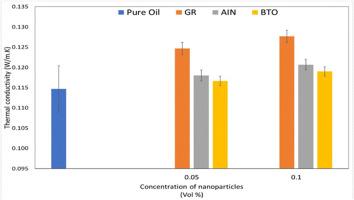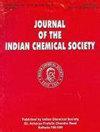Thermophysical and corrosion inhibitor evaluation of graphene, aluminum nitride and barium titanate nanolubricants
IF 3.2
4区 化学
Q2 CHEMISTRY, MULTIDISCIPLINARY
引用次数: 0
Abstract
A newly developed kind of fluid known as nanolubricant is produced by dispersing nanometer-sized materials in base oil. The main issue with nanolubricant is particle stability, which occurs when nanoparticles aggregate due to van der Waals forces. The aim of the study is to evaluate the performance of graphene (GR), aluminium nitride (AlN), and barium titanate (BTO) nanolubricants at 0.05 and 0.1 vol % concentrations. The stability was identified by using sedimentation photograph capturing method and zeta potential analysis, while KD2 Pro Analyzer was used to measure the thermal conductivity, and the effect of corrosion inhibitor evaluation was measured according to ASTM D130-19. The nanolubricants are prepared by two-step method and undergo ultrasonication process to ensure the nanoparticles are well dispersed in base oil. The results showed that nanolubricants containing 0.05 vol % nanoparticles are more stable than 0.1 vol % nanolubricants. Nanolubricants with 0.1 vol % showed signs of instability based on low zeta potential values. This is due to the fact that the higher the concentration of nanoparticles, the closer the nanoparticles are to one another. This increased van der Waals attraction and potentially causing nanoparticle agglomeration. Improvement in thermal conductivity was obtained with high volume concentration of GR, AlN and BTO nanoparticles. All nanolubricants achieved an ASTM Standard D130 classification of 1a based on the Copper Strip Corrosion Test Standard (slight tarnish, slight colour change). As a result, it was discovered that all prepared samples are effective anticorrosion lubricating oil additives.

石墨烯、氮化铝和钛酸钡纳米润滑剂的热物理和腐蚀抑制剂评估
一种新开发的润滑油被称为纳米润滑油,是通过在基础油中分散纳米级材料而制成的。纳米润滑剂的主要问题是颗粒稳定性,当纳米颗粒因范德华力而聚集时就会出现这种问题。本研究旨在评估浓度为 0.05 和 0.1 Vol % 的石墨烯 (GR)、氮化铝 (AlN) 和钛酸钡 (BTO) 纳米润滑剂的性能。使用沉降照片捕捉法和 ZETA 电位分析确定了稳定性,同时使用 KD2 Pro 分析仪测量了热导率,并根据 ASTM D130-19 标准测量了缓蚀剂的效果评估。纳米润滑剂采用两步法制备,并经过超声处理,以确保纳米颗粒在基础油中充分分散。结果表明,含 0.05 Vol % 纳米粒子的纳米润滑剂比含 0.1 Vol % 纳米粒子的纳米润滑剂更稳定。根据较低的 zeta 电位值,0.1 Vol % 的纳米润滑剂显示出不稳定的迹象。这是由于纳米粒子的浓度越高,纳米粒子之间的距离就越近。这增加了范德华吸引力,并可能导致纳米粒子聚集。高浓度的 GR、AlN 和 BTO 纳米粒子可提高导热性。根据铜带腐蚀测试标准,所有纳米润滑剂都达到了 ASTM 标准 D130 的 1a 级分类(轻微褪色、轻微变色)。结果发现,所有制备的样品都是有效的防腐蚀润滑油添加剂。
本文章由计算机程序翻译,如有差异,请以英文原文为准。
求助全文
约1分钟内获得全文
求助全文
来源期刊
CiteScore
3.50
自引率
7.70%
发文量
492
审稿时长
3-8 weeks
期刊介绍:
The Journal of the Indian Chemical Society publishes original, fundamental, theorical, experimental research work of highest quality in all areas of chemistry, biochemistry, medicinal chemistry, electrochemistry, agrochemistry, chemical engineering and technology, food chemistry, environmental chemistry, etc.

 求助内容:
求助内容: 应助结果提醒方式:
应助结果提醒方式:


